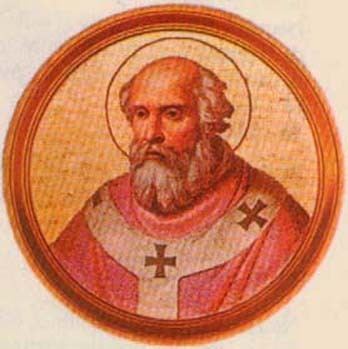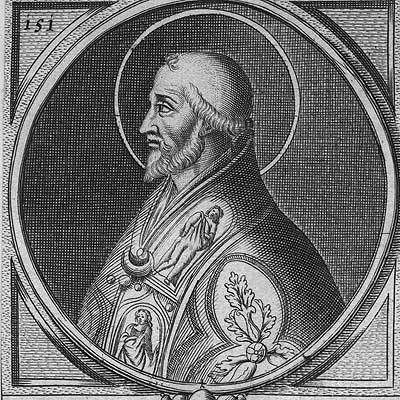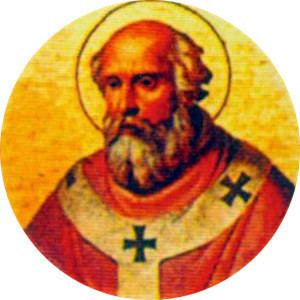Papacy began 12 February 1049 Consecration 1026 Papacy ended 19 April 1054 Name Pope IX | Nieces Matilda of Frisia | |
 | ||
Birth name Bruno von Eguisheim-Dagsburg Parents Heilwig von Dagsburg, Count Hugh Siblings Gertrud, wife of Liudolf of Frisia Nephews Egbert I, Margrave of Meissen Similar People Michael I Cerularius, Pope Gregory VII, Pope Leo II, Pope John XII, Pope Leo III | ||
Pope leo ix
Pope Leo IX (21 June 1002 – 19 April 1054), born Bruno of Egisheim-Dagsburg, was Pope from 12 February 1049 to his death in 1054. He was a German aristocrat and a powerful ruler of central Italy while holding the papacy. He is regarded as a saint by the Roman Catholic Church, his feast day celebrated on 19 April.
Contents

Leo IX is widely considered the most historically significant German Pope of the Middle Ages.

Pope leo ix
Early life

He was born to Count Hugh and Heilwig and was a native of Eguisheim, Upper Alsace (present day Alsace, France). His family was of noble rank, and his father, Count Hugh, was a cousin of Emperor Conrad II (1024–1039). He was educated at Toul, where he successively became canon and, in 1026, bishop. In the latter capacity he rendered important political services to his relative Conrad II, and afterwards to Emperor Henry III. He became widely known as an earnest and reforming ecclesiastic by the zeal he showed in spreading the rule of the order of Cluny.
Papacy

On the death of Pope Damasus II in 1048, Bruno was selected as his successor by an assembly at Worms in December. Both the Emperor and the Roman delegates concurred. However, Bruno apparently favored a canonical election and stipulated as a condition of his acceptance that he should first proceed to Rome and be freely elected by the voice of the clergy and people of Rome. Setting out shortly after Christmas, he met with abbot Hugh of Cluny at Besançon, where he was joined by the young monk Hildebrand, who afterwards became Pope Gregory VII; arriving in pilgrim garb at Rome in the following February, he was received with much cordiality, and at his consecration assumed the name Leo IX.
Leo IX favored traditional morality in his reformation of the Catholic Church. One of his first public acts was to hold the well-known Easter synod of 1049, at which celibacy of the clergy (down to the rank of subdeacon) was required anew. Also, the Easter synod was where the Pope at least succeeded in making clear his own convictions against every kind of simony. The greater part of the year that followed was occupied in one of those progresses through Italy, Germany and France which form a marked feature in Leo IX's pontificate. After presiding over a synod at Pavia, he joined Henry III in Saxony and accompanied him to Cologne and Aachen. He also summoned a meeting of the higher clergy in Reims in which several important reforming decrees were passed. At Mainz he held a council at which the Italian and French as well as the German clergy were represented, and ambassadors of the Greek emperor were present. Here too, simony and the marriage of the clergy were the principal matters dealt with.
After his return to Rome he held another Easter synod on 29 April 1050. It was occupied largely with the controversy about the teachings of Berengar of Tours. In the same year he presided over provincial synods at Salerno, Siponto and Vercelli, and in September revisited his native Germany, returning to Rome in time for a third Easter synod, at which the question of the reordination of those who had been ordained by simonists was considered.
In 1052 he joined the Emperor at Pressburg and vainly sought to secure the submission of the Hungarians. At Regensburg, Bamberg and Worms, the papal presence was celebrated with various ecclesiastical solemnities.
In constant fear of attack from the Normans in the south of Italy, the Byzantines turned in desperation to the Normans' own spiritual chief, Pope Leo IX, and, according to William of Apulia, begged him "to liberate Italy that now lacks its freedom and to force that wicked people, who are pressing Apulia under their yoke, to leave." After a fourth Easter synod in 1053, Leo IX set out against the Normans in the south with an army of Italians and Swabian mercenaries. "As fervent Christians the Normans were reluctant to fight their spiritual leader and tried to sue for peace but the Swabians mocked them – battle was inevitable." Leo IX led the army himself, but his forces suffered total defeat at the Battle of Civitate on 15 June 1053. Nonetheless, on going out from the city to meet the victorious enemy he was received with every token of submission, pleas for forgiveness and oaths of fidelity and homage. From June 1053 to March 1054 the Pope was nevertheless held hostage at Benevento, in honourable captivity, until he acknowledged the Normans conquests in Calabria and Apulia. He did not long survive his return to Rome, where he died on 19 April 1054.
Leo IX sent a letter to Michael Cærularius, Patriarch of Constantinople, in 1054, that cited a large portion of the Donation of Constantine, believing it genuine. The official status of this letter is acknowledged in the 1913 Catholic Encyclopedia, Volume 5, entry on Donation of Constantine, page 120:
"The first pope who used it in an official act and relied upon it, was Leo IX; in a letter of 1054 to Michael Cærularius, Patriarch of Constantinople, he cites the "Donatio" to show that the Holy See possessed both an earthly and a heavenly imperium, the royal priesthood."Leo IX assured the Patriarch that the donation was completely genuine, not a fable, so only the apostolic successor to Peter possessed that primacy and was the rightful head of all the Church. Before his death, Leo IX had sent a legatine mission under Cardinal Humbert of Silva Candida to Constantinople to negotiate with Patriarch Michael I Cerularius in response to his actions concerning the church in Constantinople. Humbert quickly disposed of negotiations by delivering a bull excommunicating the Patriarch. This act, though legally invalid due to the Pope's death at the time, was answered by the Patriarch's own bull of excommunication against Humbert and his associates and is popularly considered the official split between the Eastern and Western Churches. The Patriarch rejected the claims of papal primacy, and subsequently the One Church was split in two in the Great East–West Schism of 1054.
